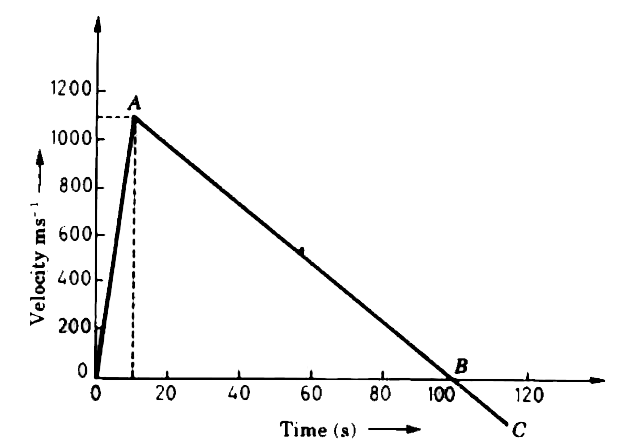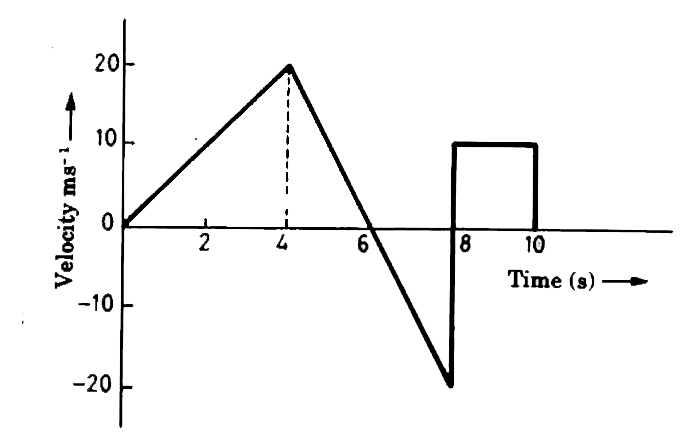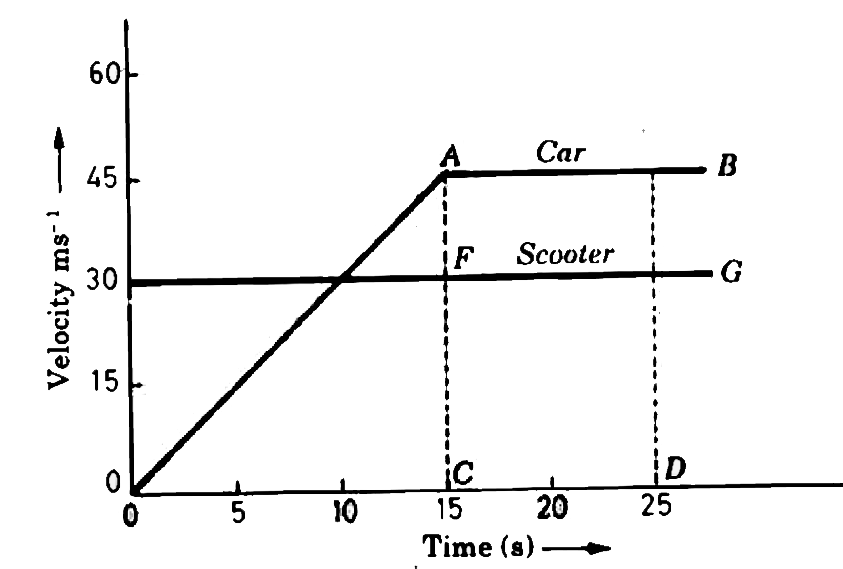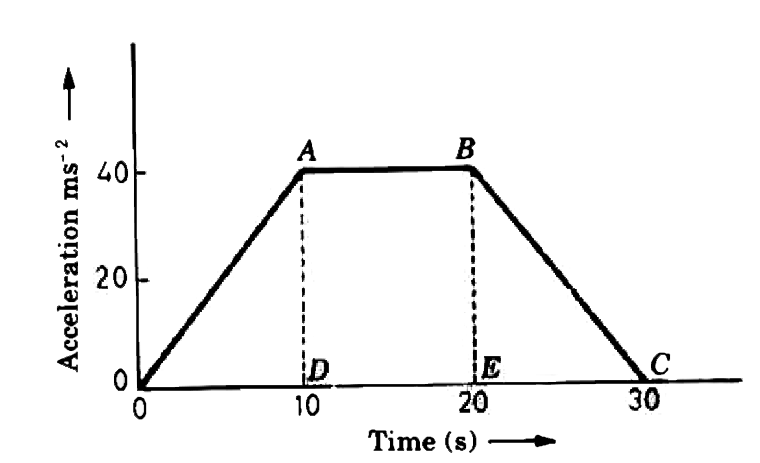Complete Solutions to problems for self practice of chapter MOTION IN ONE DIMENSION of Class 11 book with complete answers and questions
| Class 11 | PHYSICS |
| Chapter | MOTION IN ONE DIMENSION |
| SL ARORA | problems for self practice |
| Number Of Questions | 66 |
| Academic Year | 2023-24 |
A person moves on a semi - circular track of radius radius 42 m during a morning walk. He starts at one end of the track and reaches the other end. Find the distance covered and the displacment of the person .
View SolutionA car covers the first half of the distance between two places at a speed of `40 kmh^(-1)` and the second half at`60 kmh^(-1)` the next 15 minutes,and then with a speed of `60 kmh ^(-1)`.what is the average speed of the car ?
View SolutionA train moves with a speed o f`30kmh^(-1)` in the first 15 minutes,with another speed of `40kmh^(-1)` the next 15 minutes,and then with a speed of `60 kmh^(-1)` in the last 30 minutes. Calculate the average speed of the train of train for this journey.
View SolutionA body describes the first half of the total distance with velocity `v_1` and the second half and velocity `v_2`.Calculate the average velocity.
View SolutionA body travels a distance `s_(1)` with vleocity `v_(1)` and distance `s_(2)` with velocity `v_(2)` in the with velocity `v_(2)` . Calculate the average velocity.
View SolutionA car covers 1/4 of the total distance with velocity of `20 ms^(-1)`,next 1/4 part with the velcoity of `40 ms^(-1)`. The `20ms^(-1)` and last 1/4 part with the velocity of `40 ms^(-1)` . Find the averafe speed of the car.
View SolutionA car along a starigth line for the first half time with speed `50 kmh^(-1)` and the second half time with speed `60kmh^(-1)`. Find the average speed of the car.
View SolutionA train A moves with a unifrom velocity of `60 kmh^(-1)` another train B moves in the same direation with a unifrom velocity of `80 kmh^(-1)`(a) wghat is the relactive velocity of a with respect to B? (b) what is the relative velocity of B with respect to A ?
View Solutiontwo train A and B are moving on parallel tracks with velocities of `60 kmh^(-1) and `90kmh^(-1)` respectively but in oppiste directions. Find (i) the relative velocity of train A.w.r.t train B and (ii) the relative velocity of ground w.r.t tain A.
View SolutionA jet airplane travelling at the speed of `450 kmh ^(-1)`ejects the burnt gases at the speed of `1200 kmh^(-1)` relative to the jet airplane. Find the speed of the brunt gases w.r.t a stationary observer on earth .
View Solutiontwo car A and B are moving with velocities of `60 kmh^(-1) and 45 kmh^(-1)` respectively. Calculate the relative velocity of A w.r.t B if (i) both cars are travelling eastwards and (ii)car A is travelling eastwards and car B is travelling westwards.
View Solutionan open car is moving on a road with a speed of `100 kmh ^(-1)` . A man sitting in the car fires a bullet from the gun in the oppositve direction. If the spedd of the bullet is `250kmh ^(-1)` relative to the car.then find its (bullt 's ) speed with respect to an observe on the ground.
View SolutionA car A is moving with is speed of `60kmh^(-1)` an car B is moving with a speed of `75 kmh^(-1)` ,along parallel straight paths , starting paths starting from the same point. What is the position of car A w.r.t B after 20 minutes ?
View Solutiontwo trains A and B,each of length 100 m, in length are running in opposite driection on parallel tracks with velocities ` 40 kmh ^(-1) and 32 kmh^(-1)` . In what time will they completely cross each other ?
View Solutiontwo buses start simultaneoulsly towards each othehr from towns A and B which are 480 km apart. The first bus taken 8 hours to travel form A to B while the second bus takes 12 hours to travel from B to A. determine when and where the buses will meet.
View SolutionTwo trains, each of length ` 100 m`, are running on parallel tracks. One overtakes the other in `20 second ` and one crosses the other in `10 second`. Calculate the velocities of two trains.
View SolutionA man swins in a river with and against water at the rate of `15 kmh ^(-1) and 5 kmh^(-1)` . Find the man's speed in still water and the speed of the river.
View SolutionA motrobaot covers the distance between the two sport on the river is 8 h and 12 h downstream and upstream respecitvley . Find the time required by the boat to cover the distance in still water.
View Solutiontwo men can swin in still water at the rate of `5 kmh^(-1)` . One of them swims downstream throgh a distance of 2 km and another swims upstream through an equal distance. Find the difference in time taken by them, if the velocity of the flow of river is `3kmh^(-1)`.
View SolutionA body starts to slide over a horizontal surface with an initial velocity of `0.5 kmh^(-1)`.due to friction, it velocity decreases at a rate of `0.05 ms^(-2)` .how much time will it take for body to stop ?\
View SolutionAn electron is emittied with a veloctiy of ` 5 xx 10 ^(6) ms^(-1)` . It is accelerated by an electric field in the direction of initial velocity at `3xx 10^(14) ms^(-2)` . If its final velocity is `7xx10^(6) ms^(-1)` calculation the distance coverd by the electron .
View SolutionA car moving along a stainght highway with a speed of `72 kmh^(-1)` is brought to a stop within a distance of 100m. What is the retardation of the car and how long does it takes for the car to stop ?
View Solutionon turning a corner a car driving at `36kmh^(-1)` finds a child on the road 55 m abead. He immediately applies brakes,so as to stop within 5 m of the child . Calculate the retardation produced and the time taken by the car to stop .
View SolutionA car A is travelling on a straight level road with a uniform speed of 60 km/h. It is followed by another car B which in moving with a speed of 70 km/h. When the distance between then is 2.5km, the car B is given a deceleration of `20(km)/(h^2)`. After how much time will B catch up with A
View SolutionA bullet going with speed 350 m/s enters concrete wall and penetrates a distance of 5.0 cm before coming to rest. Find the deceleration.
View Solutionthe reaction time for an automobile drive os 0.6s if the automobile can be decelerated at `5 ms^(-2)` , calculate the total distance travelled in coming to stop fro, an intial velocity of `30kmh ^(-1)` after a singnal is observed.
View SolutionA racer cover a distance of 400 m as follows. He first increasese his speed of first quarter of the distance and covers this distance in 10 s. after that he runs at the speed so developed. Calculate the total time taken by the racer to cover the distacne .
View SolutionA car starts from rest and accelerates uniformly for `10 s`to a velocity of `80 ms ^(-1)`. It then runs at a constant velocity and is finally brought to rest in `64 m` with a constant retardation. The total distance covered by the car is `584 m` Find the value of acceleration, retardation, and total time taken.
View Solutiontwo tains one travelling at `72kmh^(-1)` and other at `90 kmh ^(-1)` are heading towards one another along a strauight level track. When they are 1.0km apart, both the drivers simultanously see the other 's train and apply brakes which restard each train at the rate of `1 .0ms^(-2)`.determine whether the trains would collide or not.
View SolutionA burglar's car had a start with an acceleration of `2ms^(-1)` . A police van came after 5 second and continued to chase the burglar's car with a uniform velocity of `20 ms ^(-1)`. Find the time in which the police van overtakes the burglar's car .
View SolutionA ball rolls down an inclined track 2 m long 4s. Find (i) acceleration (ii) time taken to cover the second metre of the track and (iii) speed of the vall at the bottom of the track.
View SolutionA drive of a mail train travelling `108 kmh^(-1)` sees a passenger train which is 250 m ahead on the same tarck. The passenger train is travelling in the same direation as the mail train. The velocity of the passenger train is `36^(-1)` .the driver of the mail train immediatly applies the brakes so as to produces a constant deaceleration of `1ms^(-2)` wherease the passenger train continues with the constant speed (i) calculate and find wheater there will be a collision (ii) if the collision occcurs where will it take place ?
View SolutionA bus starts from rest with a constant acceleration of `5 ms^(-1)` overtakes andpasses the bus . Find(i) at what distance will the bus overtake the car ? (ii) how fast will the bus be travelling then ?
View SolutionA train starte from rest and moves with a constant acceleration of `2ms^(-2)` for half a minute. The brakes are then applied and the train comes to rest in one minute.find (i) the maximum speed attained by the train (ii) the total distance moves by the train and (ii) the positions (s) of the train a half the maximum speed.
View SolutionA body covers 20 m in the 2nd second and 40 m in the 4th second of its motion . If its moiton is uniformaly accelaerated, hwo much distance will it cover in the 7 th second of its motion ?
View SolutionA body travels a distance of 2 m in 2 seconds and 2.2m next 4 secs. What will be the velocity of the body at the end of `7 th second from the start ?
View SolutionA body covers a distance of 4 m si 3rd second and 12 m in 5 th second. If the motion `25 ms ^(-1)` and after 8 second ,it is uniformly accelerted ,how far will it travel in the next 3 second ?
View SolutionAn object is moving with a uniform acceleration. Its velocity after `5 s` is `25 ms^(-1)` and after ` 8 s` is `34 ms^(-1)` Find the distance travelled by the object in `10th` second.
View SolutionA stone is thown vertically upwards with a velocity of `4.9 ms ^(-1)`. Calculate (i) the maximum height reached (ii) the time taken to reach the maximum height (iii) the velocity with which it returns to the ground and (iv) the time taken to reach the ground.
View SolutionA body is thrown vertically up from the top fo atower with a velocity of `5 ms ^(-1)` . It reaches the gorund after 5 s. find the heigth of the tower
View SolutionA ball thrown vertically up retruns to the thrower after 6 s. find the velocity with which it was thrown and its position after 4 s.
View SolutionA stone is thrown upwards from the top of tower 85 m high , reaches the ground in 5 s. find (i) the greatest height it reaches above the ground (ii) the velocity with which it reaches the ground and (iii) the time taken to reach the maximum height . Take g =` 10ms ^(-2)`?
View Solutionfrom the top of multi-storeyed building ,39.2 m tall , a boy projects a stone vertically upward with an initial velocity of `9.8 ms^(-1)` such that it finally drops to the ground (i) when will the stone reach the ground? (ii) whn will it pass through the point of projection ? (iii) what will be its velocity before striking the ground ? take g =`10ms^(-2)`
View SolutionA rocket is fired vertically up from the ground with a resultant vertical acceleration of `10 m//s^2.` The fuel is finished in 1 min and it continues to move up. (a) What is the maximum height reached? (b) Afte2r how much time from then will the maximum height be reached?(Take `g= 10 m//s^2`)
View SolutionA ballon is assconding at the rate of `14 ms ^(-1)` at a height of 98 m above the ground when velocity does it reach the ground ? Take g`9.8ms ^(-2)`.
View SolutionA stone is dropped from a ballon rising upwards with a velocity of `16 ms ^(-1)`. The stone reached the ground in 4s. Calculate the height of the ballon when the stone was dropped.
View SolutionA stone is dropped from the top of a tower 200 m high. At the same time, another stone is projected vertically upwards from the ground with a velocity of `40m//s`. Calcuate when and where the two stones will mest.
View SolutionA body is dropped from the top a towar 150 m, and sumultaneously, another body is dropped from rest from rest from a point 100m above the gorund. What is their differnece in height after they have fallan (i) 2 s(ii) 3s.how does the difference in height vary with time ? take g `10 ms^(-2)`
View SolutionA body falling freely under gravity passes two points 30 m apart in 1 s. find from what point above the upper point it began to fall ? Take g `9.8^(-2)`
View SolutionA stone is dropped from the top of tall tower and one second later another stone is dropped from a balcany 20 m below the top . If both the stones reach the ground at the same instant , determine the height of the tower .take `g = 10 ms^(-2)`
View SolutionA parachutist after bailing out falls 50 m ,whitout friction. When the parachute opens he decelerates downwards at `2ms ^(-2)`. He reaches the ground with a speed of `3ms ^(-1)`. How long was the parachustintist in air ? At wht height did he ball out ?
View SolutionA body falling freely from rest from the top of a tower describes 60.1 m in the last second of its fall. Find the height of the tower.
View SolutionA stone is dropped from a balloon at an altitude of '300 m'. How ling will the stone take to reach the ground of (a) the balloon is ascending with a velocity of ' 5 ',ms^(-1). (b) the balloon is descending with a velocity of ' 5 ms^(-1)' (c ) the balloon is stationary ?
View Solutionfour balls are dropped from the top of a tower at intervals of one - one secnod. The frist ball reaches the ground after 4s of dropping . What are the distance between first and second , second and third, third and fourth balls at this instant ?
View SolutionA particle moves along X-axis in such a way that its coordinate X varies with time t according to the equation `x = (2-5t +6t^(2))m`. The initial velocity of the particle is
View SolutionThe displacement of a particle along the x-axis is given by `x=3+8t+7t^2`. Obtain its velocity and acceleration at `t=2s`.
View Solutionthe distance traversed by a particle moving along a stranigt line is given by `x=180t+50t^(2)` metre .find
the initial velcoity of the particle.
(ii) the acceleration of the particle .
View SolutionShows the position-time graphs of three cars `A,B` and `C` On the basis of the graphs answer the follwing questions:
 .
.
a. Which car has the highest speed and which the lowest?
b. Are the three cars evrs at the same point on the road?
c. When `C` passes `A`, wher is `B`?
d. What is the time interval during car `A` travel between the time it passed cars `B` and `C` ?.
e. What is the relative velocty of car `B` with respect to car `C`?
View SolutionAn insect crawling up a wall crawls 3 cm upwords in the first minute but then slides 3cm downwards in the next minute. It again crawls up 5 cm upwards in the third mintue but again slides 3cm downwards in the fourth minute. How long will the insect take to reach a carrives in the wall at a height of 25 cm from its starting point ? how does thr position - time graph of the insect look like ?
View Solutiona driver of a car travelling at `52 km//h` applies the brakes and acceleration uniformly in the opposite direction. The car stops in `5 s`. Another driver going at `34 km//h` in another car applies his brakes slowly and stops in `10 s`. On the same graph paper, plot the speed versus time graphs for the two cars. Which of the two cars travelled farther after the brakes were applied ?
View Solutionstarting form rest a cars moves with unifrom acceleration and attians a velocity of `20 ms^(-1) and 4 s`. It then moves what a unifrom velocity of `20 ms^(-1)` for 6s. The brakes are applied and the car is brought to rest in 10s under unifrom retardation . Draw the velocity group for the motion. using theis graph , find (i) the acceleration of the car during the frist 4 s (ii) ua retardation during the last 10 s and (iii) the total distance traveled by the car .
View Solutionfig 3.36 showns the velocity time graph of a rocket projeted upwards. Assuming the firction is neglibel a dtermine from this graph (i) the time for which fuel bruns (ii) accending and descerding part of the rocket and (iii) maximum height atteined by the rocket .

View SolutionA motor car, starting from rest, moves with uniform acceleration and attains a velocity of `8ms^(-1)` in 8 s. It then move with uniform velocity and finally brought to rest in 32 m under uniform retardation. The total distance covered by the car is 646 m. Find (i) the acceleration (ii) the retardation and (iii) the total time taken.
View SolutionThe velocity-time graph of an object moving along a straight line is as shown in Fig. 3.37. Find the net distance covered by the object in time interval between t=0 to t=10s. Also find the displacement in time 0 to 10 s.

View SolutionAs soon as a car just starts from rest in a certain direction, a scooter moving with a uniform speed overtake the car. Their velocity- time graphs are shown in Fig. 3.38. Calculate (i) the difference between the distance travelled by the car and

the scooter in 15 s (ii) the time when the car will catch up the scooter and (iii) the distance of car and scooter from the starting point at that instant.
View SolutionFig. 3.39 shows the acceleration - time graph for a particle in rectilinear motion. Find the average acceleration in first 20 s.

View Solution
problems for self practice questions and complete solutions for chapter MOTION IN ONE DIMENSION of DHANPAT RAI & CO PHYSICS (HINGLISH) of Class 11